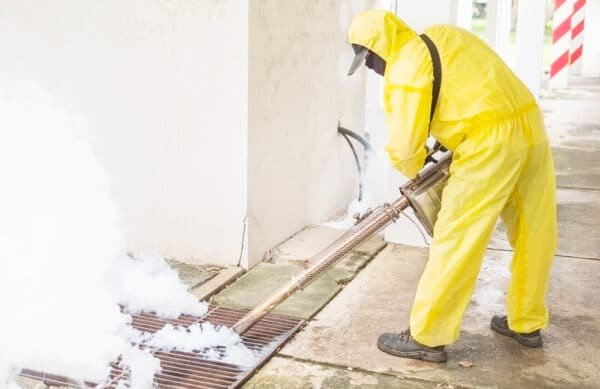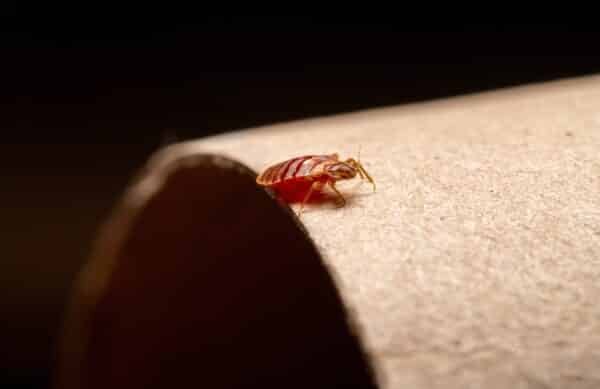According to the EPA, there are more than 300 registered and approved chemicals that can be used for the treatment of bedbugs. Broken down further, all 300 chemicals fall into one of six chemical types: biochemicals, desiccants, insect growth regulators, neonicotinoids, pyrethrins/pyrethroids, or pyrroles.
While these 300 chemicals have been approved by the EPA, many of them require handling by trained professionals and are not recommended for at-home use. This can make it tough to determine chemical treatments are viable options for you and your family.
In order to make the choice easier, we’ve put together a brief walk-through of each of these chemical families and what exactly they do when it comes to controlling bed bugs.
Biochemicals
There is one biochemical pesticide known to be effective toward bed bugs, and that is cold-pressed neem oil. This oil is derived from the seeds of the Neem tree, a species of tropical evergreen grown in Africa and Southeast Asia. Compounds within the oil act as a natural form of insecticide, and a variety of scientific trials have shown this biochemical agent to be effective against bed bugs at stages of their life cycle.
Desiccants
Desiccants are extremely valuable in terms of bed bug treatments because bed bugs cannot become resilient to their effects unlike other insecticides. Desiccants work by attacking the waxy outer-layer coating bed bugs, thus making them far more susceptible to the elements and, more specifically, dehydration. Common examples of this chemical family include boric acid and diatomaceous earth.
Keep in mind that when using desiccants, it is essential that you ensure the chemicals you are using are registered by the EPA and are intended for the control and treatment of bed bugs. This is because desiccants come in a multitude of forms and can be used for a number of purposes (including in swimming pools), so you will want to be sure you’re using the correct chemical. In addition, desiccants should be limited to ONLY cracks and crevices that may contain bed bugs or bed bug eggs as this type of chemical poses a n inhalation risk.
Insect Growth Regulators
Insect growth regulators work by mimicking juvenile growth hormones in a variety of insects. This, in turn, affects the way an insect is able to create its external shell (or exoskeleton), or interrupts an insect’s ability to develop and mature into adulthood. Depending upon the individual chemical, some insect growth regulators may cause an insect to grow too quickly and others to stop developing altogether.
Neonicotinoids
Like desiccants, neonicotinoids are another chemical agent that will work on bed bugs even if they’re resistant to other forms of chemicals like pyrethrins or pyrethroids. Neonicotinoids are synthetic, meaning they are man-made and do not derive from a natural source, and are designed to affect the nicotinic reactors that are naturally present in the nervous system. Essentially, neonicotinoids cause nerves to fire continuously until they ultimately fail.
Pyrethrins/Pyrethroids
The first grouping of chemicals includes pyrethrins and pyrethroids. Both are common compounds that are used frequently to kill bed bugs and other common household pests. Pyrethrins are an organic chemical treatment derived from the chrysanthemum flower while pyrethroids are synthetic and designed to act like pyrethrins.
While both chemical compounds will kill bed bugs, recent years have shown a strain of bed bugs that are resistant to these chemicals. In these cases, using a combination of pyrethrins and pyrethroids (or using these chemicals in conjunction with other chemical classes) can provide better results.
Have you heard of “foggers” being used to kill bed bugs? Both pyrethrins and pyrethroids can be found in the form of “total release foggers” for bed bug treatment.
Pyrroles
There is only one type of pyrrole that can be used in the treatment of bed bugs: chlorfenapyr. Chlorfenapyr is what is known as a “pro-insecticide,” meaning that it requires activation from another chemical in order to work properly. The resulting chemical is on that affects a variety of functions within the body of a bed bug, thus causing its death.
While these chemicals may all be effective at killing bed bugs, pesticides should be used with extreme caution and are not recommended for individuals who are unfamiliar with chemical pest control treatments. Presidio Pest Management is here to make sure your home stays safe and free of bed bugs. Call us with your questions or schedule your free home inspection today and let our highly experienced team take care of the problem for you.





